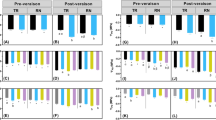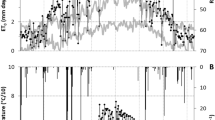Abstract
We evaluated three approaches for scheduling irrigation in wine grape vineyards and in olive, apple and Asian pear tree orchards, based on sap flow measurements and models of plant transpiration. In the first approach, we analysed how the shape of the sap-flow profile changed in response to root-zone soil water conditions and potential evaporative demand. The second approach was based on a transpiration ratio, as defined from the actual daily water use of a target plant divided by the potential daily water use of similar-sized plants under non-limiting soil water conditions (“well-irrigated” plants). Values of the actual plant water use were always determined from measured sap flow. Two independent methods were assessed for the calculation of potential plant water use; either sap flow was measured in well-irrigated plants or we used a leaf-area based model of plant transpiration. On some occasions water stress was found to modify the shape of the sap velocity profile. However, most of the time the velocity profile was found to be an insensitive indicator for triggering irrigation. The transpiration ratio method, using measured sap flow in well-irrigated plants, was more useful for irrigation scheduling, at least for the two species (i.e. olive and grape) that were investigated here. Nonetheless, realization of such an approach in a commercial orchard may not be practical due to problems associated with irrigation management e.g. excessive vegetative growth may occur on the reference plants over time. Besides, irrigating the orchard to maintain non-limiting soil water conditions is not always the best option for water and nutrient management. The alternative transpiration ratio method based on a leaf-area based model of plant water use, yielded the best results. Modelled transpiration rates always provided reliable information not only for well-irrigated plants, but also for deficit-irrigated plants. This result lends support to the use of the method for irrigation scheduling of vineyard and orchard trees. However, the use of models does require detailed microclimate data as well as a user-friendly technique to quantify plant leaf area. From a practical viewpoint the method should encompass the spatial variability of the soil and plants within the orchard. Accurate quantification of these factors is a cornerstone of precision horticulture and such information would help to minimise risks associated with insufficient as well as excessive irrigation applications.










Similar content being viewed by others
References
Allen R, Pereira LS, Raes D, Smith M (1998) Crop evapotranspiration – guidelines for computing crop water requirements – FAO irrigation and drainage paper 56. FAO, Rome
Berenguer MJ, Vossen PM, Grattan SR, Connell JH, Polito VS (2006) Tree irrigation levels for optimum chemical and sensory properties of olive oil. Hortic Sci 41:427–432
Caspari HW, Behboudian MH, Chalmers DJ, Renquist AR (1993a) Pattern of seasonal water use of Asian pears determined by lysimeters and the heat-pulse technique. J Am Soc Hortic Sci 118(5):562–569
Caspari HW, Green SR, Edwards WRN (1993b) Transpiration of well-watered and water-stressed Asian pear trees as determined by lysimetry, heat-pulse, and estimated by a Penman–Monteith model. Agric Forest Meteorol 67:13–27
Caspari HW, Behboudian MH, Chalmers DJ (1994) Water use, growth, and fruit yield of ‘Hosui’ Asian pears under deficit irrigation. J Am Soc Hortic Sci 119(3):383–388
Cermak J, Nadezhdina N (1998) Sapwood as the scaling parameter – defining according to xylem water content or radial patter of sap flow? Ann Sci For 55:509–521
Chalmers DJ, Andrews PK, Harris KM, Cameron EA, Caspari HW (1992) Performance of drainage lysimeters for the evaluation of water use by Asian pears. Hortic Sci 27:263–265
Clothier BE, Scotter DR, Kerr JP (1977) Drainage flux in permeable soil underlain by a coarse-textured layer. Soil Sci Soc Am J 41:671–676
de Souza CR, Maroco JP, dos Santos TP, Rodrigues ML, Lopes CM, Pereira JS, Chaves MM (2003) Partial rootzone drying: regulation of stomatal aperture and carbon assimilation in field-grown grapevines (Vitis vinifera cv. Moscatel). Funct Plant Biol 30:653–662
de Souza CR, Maroco JP, dos Santos TP, Rodrigues ML, Lopes CM, Pereira JS, Chaves MM (2005) Control of stomatal aperture and carbon uptake by deficit irrigation in two grapevine cultivars. Agric Ecosys Environ 106:261–274
Diaz-Espejo A, Hafidi B, Fernández JE, Palomo MJ, Sinoquet H (2002) Transpiration and photosynthesis of the olive tree: a model approach. Acta Hortic 586:457–460
Diaz-Espejo A, Walcroft AS, Fernández JE, Hafidi B, Palomo MJ, Girón IF (2006) Modeling photosynthesis in olive leaves under drought conditions. Tree Physiol 26:1445–1456
dos Santos TP, Lopes CM, Rodrigues ML, de Souza CR, Maroco JP, Pereira JS, Silva JR, Chaves MM (2003) Partial rootzone drying: effects on growth and fruit quality of field-grown grapevines (Vitis vinifera). Funct Plant Biol 30:663–671
Escalona JM, Flexas J, Medrano H (2002) Drought effects on water flow, photosynthesis and growth of potted grapevines. Vitis 41:57–62
Fereres E, Evans RG (2006) Irrigation of fruit trees and vines: an introduction. Irrig Sci 24:55–57
Fereres E, Goldhamer DA, Parsons LR (2003) Irrigation water management of horticultural crops. HortScience 38(5):1036–1043
Fernández JE, Moreno F, Girón IF, Blázquez OM (1997) Stomatal control of water use in olive tree leaves. Plant Soil 190:179–192
Fernández JE, Palomo MJ, Díaz-Espejo A, Clothier BE, Green SR, Girón IF, Moreno F (2001) Heat-pulse measurements of sap flow in olives for automating irrigation: tests, root flow and diagnostics of water stress. Agric Water Manag 51:99–123
Fernández JE, Diaz-Espejo A, Infante JM, Durán P, Palomo MJ, Chamorro V, Girón IF, Villagarcía L (2006a) Water relations and gas exchange in olive trees under regulated deficit irrigation and partial rootzone drying. Plant Soil 284:271–287
Fernández JE, Durán PJ, Palomo MJ, Díaz-Espejo A, Chamorro V, Girón IF (2006b) Calibration of sap flow measurements by the compensation heat-pulse method in olive, plum and orange trees: relations with xylem anatomy. Tree Physiol 26:719–728
Fernández JE, Diaz-Espejo A, d’Andria R, Sebastiani L, Tognetti R (2007) Potential and limitations of improving olive orchard design and management through modeling. Plant Biosyst (in press)
Goldhamer DA, Fereres E (2001) Irrigation scheduling protocols using continuously recorded trunk diameter measurements. Irrig Sci 20(3):115–125
Granier A (1987) Evaluation of transpiration in a Douglas-fir stand by means of sap flow measurements. Tree Physiol 3:309–320
Grattan SR, Berenguer MJ, Connell JH, Polito VS, Vossen PM (2006) Olive oil production as influenced by different quantities of applied water. Agric Water Manag 85:133–140
Green SR, Clothier BE (1988) Water use of kiwifruit vines and apple trees by the heat-pulse technique. J Exp Bot 39:115–123
Green SR, Clothier BE, Jardine B (2003) Theory and practical application of heat-pulse to measure sap flow. Agron J 95:1371–1379
Green SR, Kirkham MB, Clothier BE (2006a) Root uptake and transpiration: from measurements and models to sustainable irrigation. Agric Water Manag 86:165–176
Green S, Neal S, Greven M, Clothier B (2006b). Maximising irrigation savings in grape vines and the effect on yield and wine quality (SFF Grant No. 03/200). Year 3. HortResearch Client Report No. 19921, 19 pp
Intrigliolo DS, Castel JR (2006) Performance of various water stress indicators for prediction of fruit size response to deficit irrigation in plum. Agric Water Manag 83:173–180
Jones HG (2004) Irrigation scheduling: advantages and pitfalls of plant-based methods. J Exp Bot 407:2427–2436
Moreno F, Fernández JE, Clothier BE, Green SR (1996) Transpiration and root water uptake by olive trees. Plant Soil 184:85–96
Moriana A, Orgaz F, Pastor M, Fereres E (2003) Yield responses of a mature olive orchard to water deficits. J Am Soc Hortic Sci 128(3):425–431
Nadezhdina N (1999) Sap flow index as an indicator of plant water status. Tree Physiol 19:885–891
Nadezhdina N, Cermak J (1997) Automatic control unit for irrigation systems based on sensing the plant water status. An Inst Super Agron 46:149–157
Nadezhdina N, Cermak J, Ceulemans R (2002) Radial patterns of sap flow in woody stems of dominant and understory species: scaling errors associated with positioning of sensors. Tree Physiol 22:907–1018
Nadezhdina N, Nadezhdin V, Ferreira MI, Pitacco A (2007) Variability with xylem depth in sap flow in trunks and branches of mature olive trees. Tree Physiol 27:105–113
Naor A (2006) Irrigation scheduling and evaluation of tree water status in deciduous orchards. Hortic Rev 32:111–165
Naor A, Cohen S (2003) The sensitivity and variability of maximum trunk shrinkage, midday stem water potential, and transpiration rate in response to withholding of irrigation in field-grown apple trees. HortScience 38:547–551
Naor A, Gal Y, Peres M (2006) The inherent variability of water stress indicators in apple, nectarine and pear orchards, and the validity of a leaf-selection procedure for water potential measurements. Irrig Sci 24:129–135
Ortuño MF, García-Orellana Y, Conejero W, Ruiz-Sánchez MC, Alarcón JJ, Torrecillas A (2006) Stem and leaf water potentials, gas exchange, sap flow, and trunk diameter fluctuations for detecting water stress in lemon trees. Trees 20:1–8
Pereira AR, Green SR, Villa Nova NA (2006) Penman–Monteith reference evapotranspiration adapted to estimate irrigated tree transpiration. Agric Water Manag 83:153–161
Phattaralerphong J, Sathornkich J, Sinoquet H (2006) A photographic gap fraction method for estimating leaf area of isolated trees: assessment with 3D digitized plants. Tree Physiol 26:1123–1136
Ray SN, Tozer CG (1990) Water and soil resources of the Wairau, vol 3 – land and soil resources. Nelson-Marlborough Regional Council, Blenheim, 206 pp
Sepulcre-Cantó G, Zarco-Tejada PJ, Jiménez-Muñoz JC, Sobrino JA, de Miguel E, Villalobos FJ (2006) Detection of water stress in an olive orchard with thermal remote sensing imagery. Agric Forest Meteorol 136:31–44
Sinoquet H, Le Roux X, Adam B, Ameglio T, Daudet FA (2001) RATP: a model for simulating the spatial distribution of radiation absorption, transpiration and photosynthesis within canopies: application to an isolated tree crown. Plant Cell Environ 24:395–406
Smart RE, Robinson M (1991) Sunlight into wine: a handbook for winegrape canopy management. Winetitles, Australia
Tyree MT, Zimmermann MH (2002) Xylem structure and the ascent of sap, 2nd edn. Springer, Berlin Heidelberg New York, p 283
van der Velde M, Green SR, Vanclooster M, Clothier BE (2006) Transpiration of squash under a tropical maritime climate. Plant Soil 280:323–337
Wullschleger ST, King AW (2000) Radial variation in sap velocity as a function of stem diameter and sapwood thickness in yellow-poplar trees. Tree Physiol 20:511–518
Acknowledgements
Experiments with olive were funded by the Spanish Ministerio de Educación y Ciencia (research projects HID96-1342-CO4-01 and AGL2002-04048-CO3-01) and by the IFAPA, Consejería de Innovación, Ciencia y Empresa de la Junta de Andalucía, (research project CO3-056).
Author information
Authors and Affiliations
Corresponding author
Additional information
Responsible Editor: Stephen S.O. Burgess.
Rights and permissions
About this article
Cite this article
Fernández, J.E., Green, S.R., Caspari, H.W. et al. The use of sap flow measurements for scheduling irrigation in olive, apple and Asian pear trees and in grapevines. Plant Soil 305, 91–104 (2008). https://doi.org/10.1007/s11104-007-9348-8
Received:
Accepted:
Published:
Issue Date:
DOI: https://doi.org/10.1007/s11104-007-9348-8




